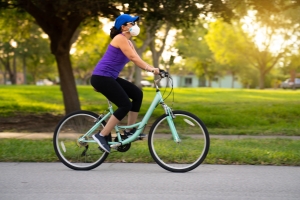By Collette Powers, MA, RDN, LDN, ACSM EP
First of all, let us start off by saying a huge congratulations! Whether you are preparing for a transplant or already received a kidney transplant, you have taken a pro-active step in your own healthcare. This is a major accomplishment and one worth much recognition. Kudos to you!
As part of the transplant journey, you learn a great deal of information regarding the transplant process. Topics may range between diet management, medication management and organ infection/rejection prevention to name a few, but what about physical activity? Can you exercise after receiving your new kidney? Should you exercise? Is it safe to exercise? These are all great questions that we will dive into addressing right now!
So, to start, why are we talking about exercise? Studies have shown several benefits to partaking of regular physical activity as part of a healthy lifestyle (1,2,3,4). Such benefits include better blood pressure control, improved sleeping patterns, strengthening of muscles and bones, improved blood circulation and increased energy (5,6). Exercise has also been shown to help with managing stress and can help with reaching an ideal healthy body weight. Even more specific to post-kidney transplant recipients, regular aerobic or “cardio” exercise plays a vital role in decreasing one’s risk for cardiovascular disease and metabolic syndrome. What is metabolic syndrome? Metabolic syndrome is defined as having at least three of the following: high blood pressure, high blood triglyceride levels, low HDL cholesterol (also known as high-density lipoprotein), excess abdominal fat and/or high blood sugar levels (7). Transplant recipients are at an increased risk for developing metabolic syndrome as a result of medication side effects from their anti-rejection medications, changes to dietary habits, and lack of exercise (8). The anti-rejection medications, or immunosuppressants, also can increase one’s risk for bone disease like osteoporosis. Weight-bearing exercises are a great way to combat this by helping to strengthen the bones and supporting muscles. Thus, incorporating various exercise types into your lifestyle can be one pro-active approach in keeping your health on track.
Okay so we know the benefits of exercise and how it can promote better health. However, one study found that less than 60% of transplant recipients participate in the recommended guidelines for physical activity (9). Why is that? A few of the reasons include low confidence level and low self-efficacy, or ability, to start and stay active. Do any of these reasons resonate with you? Keep reading further to learn how to address these concerns to leave you feeling more empowered to be physically active!
To start, let us first review what the recommendations are for physical activity. The Physical Activity Guidelines for Americans and the World Health Organization recommend at least 150 to 300 minutes weekly of moderate-intensity exercise (like brisk walking) or 75 to 150 minutes a week of vigorous-intensity (like jogging) and at least two sessions of strength/resistance training per week (10,11). Now I am not saying go from 0 to 300 minutes. There are many factors to consider when starting and progressing with an exercise plan, what I also call the START approach:
Americans and the World Health Organization recommend at least 150 to 300 minutes weekly of moderate-intensity exercise (like brisk walking) or 75 to 150 minutes a week of vigorous-intensity (like jogging) and at least two sessions of strength/resistance training per week (10,11). Now I am not saying go from 0 to 300 minutes. There are many factors to consider when starting and progressing with an exercise plan, what I also call the START approach:
- Safety. After receiving a kidney transplant, you may be limited to certain types of activities for the first several weeks as your body heals. Every person’s needs and physical capabilities are different. Some may feel they can walk miles day one where others may need extra support such as partaking of a physical rehabilitation program. Speak with your healthcare provider about what types of activities and how much you should strive for BEFORE starting. The Cleveland Clinic has a suggested list of questions to ask your provider (5):
- How much exercise can I do each day?
- How often can I exercise each week?
- What type of exercise should I do?
- What type of activities should I avoid?
- Should I take my medicines at a certain time around my exercise schedule?
Remember, do not exercise if you have a fever or are not feeling well. Stop exercising if you experience shortness of breath, chest pain, dizziness or lightheadedness. Call your doctor if the symptoms do not go away and/or if you notice any swelling (5). Certain immunosuppressants can impact one’s muscle coordination so notify your health care provider of any changes you observe (12).
- Timing. Now this topic can be taken into consideration in many ways. First is the time of day for when you plan to be active. Many of the immunosuppressants can have undesirable side effects that can impact your physical activity efforts like nausea or diarrhea. To lower your risk of stomach upset, wait 1 to 1½ hours after eating to partake of physical activity (5,6). As noted above, ask your provider about how to adjust your medication regimen to work with your exercise schedule. Second is in reference to the time of day but with respect to your environment. Immunosuppressants can increase one’s skin sensitivity to light and one’s risk for skin cancer (8). Be mindful of exercising in direct sun without protection (e.g. hat, sunscreen, etc.). Avoid extreme temperatures (e.g. too hot, cold, or humid) as that can impact your body’s ability to naturally cool and interfere with blood circulation to your muscles and organs. Third, you guessed it, also time of day but with respect to how you feel. Some may feel their best in the morning where others need a few hours to “wake up”. There is no rule that states you have to exercise at a certain time of day to get the best results. The important thing is to keep yourself safe. Trying to force yourself to exercise when you feel sleepy or fatigued can put you at risk for injury. Plus, who wants to force themselves to do something. Exercise should be an activity you look forward to!
- Assessment. Ask yourself and make arrangements to set yourself up for success to partake of regular exercise. In other words, come up with your plan:
- What is my goal? Is it to lose weight, gain strength, manage stress etc.?
- What types of activities have I been cleared to do (or not do) by my provider? Which of those activities that I can partake of do I enjoy?
- Where will I exercise? At home, at a gym, etc.
- Do I need any special equipment or space? If at home, do I have space set aside for me to exercise?
- What times(s) of day can I set aside to fit in exercise? How much time per day do I have to fit in exercise?
As we discussed earlier, each person’s physical abilities will vary. However, an ideal exercise plan includes four components (13):
-
- Aerobic—walking, bicycling, swimming, dancing
- Strength—lifting weights, toe raises, squats, push-ups
- Flexibility—stretching, yoga, tai chi
- Balance—standing on one leg, walking backwards, heel-toe walking
Discuss with your provider which types of exercises in these categories would be the most appropriate for you. For more in-depth information about these components of exercise, along with supporting resources, check out the resource section at the end of this article!
- Rough draft. So now that you know what your overall goal is and have the things in place to get started, it is time to come up with your rough draft. I call it the rough draft because you may need more revisions or “drafts” until you find that sweet spot that works for you AND THAT IS OKAY!!! If you have ever tried to make a lifestyle change before, you likely know that often it takes going back to the drawing board. Do not get discouraged! Creating change takes time and is a learning experience. You will learn through trialing what works and does not work for you, whether it is your exercise preferences, abilities, or simply a change in schedule. Hey, life happens!
So, to get started, create your SMART goal. Not to be confused with START as we have been discussing. SMART stands for Specific, Measurable, Attainable, Realistic, and Time-based. Often many focus on the end result and forget about the steps it takes to get there. By focusing on the smaller steps, you can create a more reasonable approach and learn what works for you or what does not. To help illustrate, I will use this example, “I will walk 10 minutes every day before I make dinner for one month.”
Specific: what is the exact action that will take place? Answer: walk 10 minutes
Measurable: can I track if I walked 10 minutes? Yes, with a watch, phone, timer, etc. I can also determine if it did it daily by keeping a log, writing on a calendar, etc.
Attainable: is this doable to fit into my schedule? In other words, will this goal work as part of your routine/lifestyle.
Realistic: is this a goal that can realistically be done? Consider being realistic not only in the goal itself but also in how many goals overall you set. For example, is it realistic and setting yourself up for success to work on 2 goals or 10 at a time?
Time-based: when will I plan to reach this goal? I have given myself a timeline of one month. Giving yourself a timeline allows you the opportunity for self-evaluation, which is a vital part of the learning process and also with moving forward with your journey.
For more information and examples of SMART goals, check out these resources.
- Dialysis Patient Citizens, I Can, I Will, I Did, I Will! The Importance of Setting Goals, 2017. Accessed 8 January 2021, https://www.dpcedcenter.org/staying-healthy/lifestyle/
- National Kidney Foundation 2015. A New Year, A New You: 5 Tips to Make Achieving Your Goals Possible. Accessed 8 January 2021, https://www.kidney.org/content/new-year-new-you-5-tips-make-achieving-your-goals-possible.
- American Kidney Foundation 2014. Making 2014 a Year of SMART Health Goals. Accessed 8 January 2021, https://www.kidneyfund.org/kidney-today/smart-health-goals.html.
- Triumph. Every time you complete the specific action step and when you reach your timeline, give our self some credit! Positive reinforcement encourages positive behavior. Whether you achieved your goal with flying colors or experienced a few hiccups, celebrate yourself for your hard work and for sticking with it. Now that you have reached your timeline, ask yourself are you ready to bump things up or do you need to go back and create a new “rough draft”?
Alright so we have our START approach with our SMART goals, we are ready to get active! To further support you along in your exercise journey, take a look at these following resources. And again, kudos to you for taking charge in your healthcare journey!
Exercise Resources
Check out our newest course, “Exercise and the Benefits to You and Your Kidneys” (14). This course provides more in-depth information about the benefits of exercise, how to get started and progress your exercise plan, suggested workout templates, motivation tips, staying active during the COVID pandemic and more, https://www.dpcedcenter.org/resources/online-courses/exercise-and-the-benefits-to-you-and-your-kidneys/
Additional resources you may find helpful:
- Dialysis Patient Citizens, Get Your Sweat On! Exercising for Healthier Kidneys, 2019. Accessed 8 January 2021, https://www.dpcedcenter.org/education-webinar/get-your-sweat-on-exercising-for-healthier-kidneys/
- Dialysis Patient Citizens, The Kidney Citizen, 2019. Work Those Kidneys Out! Accessed 8 January 2021, https://www.dpcedcenter.org/news-events/news/work-those-kidneys-out/
- American College of Sports Medicine, Exercise is Medicine 2021. Rx for Health Series. Accessed 8 January 2021, https://www.exerciseismedicine.org/support_page.php/rx-for-health-series/
- National Kidney Foundation 2017. Side Effects of Immunosuppressant Medications as they Affect Physical Fitness: A Physical Therapists Point of View. Accessed 8 January 2021, https://www.kidney.org/atoz/content/sideeffects
- Cleveland Clinic. Exercise Guidelines after Kidney Transplant, 2019. Accessed 8 January 2021, https://my.clevelandclinic.org/health/articles/10389-exercise-guidelines-after-kidney-transplant
- S. Department of Health and Human Services, Office of Disease Prevention and Health Promotion, Move Your Way. Activity Planner. Accessed 8 January 2021, https://health.gov/moveyourway/activity-planner
References
- Hernández-Sánchez, S. Benefits of exercise in solid organ transplant recipients. European Journal of Human Movement. 2018 (41): 175-195. Accessed 8 January 2021, https://www.researchgate.net/publication/330083299_Benefits_of_exercise_in_solid_organ_transplant_recipients
- Romano G, Lorenzon E, Montanaro D. Effects of exercise in renal transplant recipients. World J Transplant. 2012;2(4):46-50. doi:10.5500/wjt.v2.i4.46. Accessed 8 January 2021, https://www.ncbi.nlm.nih.gov/pmc/articles/PMC3782234/
- Oguchi, H., Tsujita, M., Yazawa, M. et al.The efficacy of exercise training in kidney transplant recipients: a meta-analysis and systematic review. Clin Exp Nephrol. 2019 (23): 275–284. Accessed 8 January 2021, https://doi.org/10.1007/s10157-018-1633-8
- Calella, P., Hernández-Sánchez, S., Garofalo, C. et al.Exercise training in kidney transplant recipients: a systematic review. J Nephrol. 2019 (32): 567–579 (2019). Accessed 8 January 2021, https://doi.org/10.1007/s40620-019-00583-5
- Cleveland Clinic 2019. Exercise Guidelines after Kidney Transplant. Accessed 8 January 2021, https://my.clevelandclinic.org/health/articles/10389-exercise-guidelines-after-kidney-transplant
- National Kidney Foundation 2019. Staying Fit with Kidney Disease. Accessed 8 January 2021, https://www.kidney.org/atoz/content/stayfit
- National Kidney Foundation 2021. Metabolic Syndrome after Kidney Transplantation: Are You at Risk? Access January 8 2021, https://www.kidney.org/atoz/content/metabolic_syndrome
- National Kidney Foundation 2020. Care After Kidney Transplant. Accessed January 8 2021, https://www.kidney.org/atoz/content/immunosuppression#page5
- van Adrichem EJ, Dekker R, Krijnen WP, Verschuuren EAM, Dijkstra PU, van der Schans CP. Physical Activity, Sedentary Time, and Associated Factors in Recipients of Solid-Organ Transplantation. Phys Ther. 2018;98(8):646-657. Accessed January 8 2021, https://doi.org/10.1093/ptj/pzy055
- S. Department of Health and Human Services 2018. Physical Activity Guidelines for Americans 2nd edition. Physical Activity Guidelines for Americans 2nd edition. Retrieved from https://health.gov/paguidelines/second-edition/pdf/Physical_Activity_Guidelines_2nd_edition.pdf
- Bull FC, Al-Ansari SS, Biddle S, et al. World Health Organization 2020 guidelines on physical activity and sedentary behavior. British Journal of Sports Medicine2020;54:1451-1462. Accessed January 8 2021, https://bjsm.bmj.com/content/54/24/1451
- National Kidney Foundation 2017. Side Effects of Immunosuppressant Medications as they Affect Physical Fitness: A Physical Therapists Point of View. Accessed 8 January 2021, https://www.kidney.org/atoz/content/sideeffects
- Dialysis Patient Citizens, The Kidney Citizen, 2019. Work Those Kidneys Out! Accessed 8 January 2021, https://www.dpcedcenter.org/news-events/news/work-those-kidneys-out/
- Dialysis Patient Citizens, Exercise and the Benefits to You and Your Kidneys, 2020. Accessed 8 January 2021, https://www.dpcedcenter.org/education-webinar/get-your-sweat-on-exercising-for-healthier-kidneys/
Collette Powers is a Licensed and Registered Dietitian through the Commission on Dietetic Registration and a Certified Exercise Physiologist through the American College of Sports Medicine with over eight years of experience in working with the renal population.




